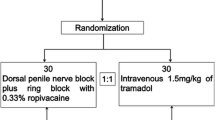Abstract
Background
Intraoperative penile erections following the initiation of either regional or general anaesthesia is rare; however, when it occurs in patients undergoing urologic procedures it may delay, or even cancel the planned surgery. The aetiology is unclear. Various treatments proposed for producing detumescence are not always effective. Use of intracavernous alpha-adrenergic agonists is an efficient and rapid but short-lasting treatment. Furthermore, repeated intracavernous injections of vasoactive drugs may be harmful. Dexmedetomidine is a potent, selective α2-adrenoreceptor agonist. In our study, we evaluated the effect of dexmedetomidine on intraoperative penile erection.
Methods
Penile erection developed during an endoscopic procedure in 12 more than 7,800 patients. Anaesthesia used was general in 3 patients, epidural in 1 patient and spinal in 8 patients. The erection rigidity was evaluated by the operating urologist. Dexmedetomidine was diluted in normal saline to a concentration of 4 μg/ml. In all of the cases, 0.5 μg/kg dexmedetomidine was injected intravenously.
Results
The incidence of intraoperative penile erection was 0.34% for general anaesthesia, 0.11% spinal anaesthesia and 1.72% epidural anaesthesia at our institution. Detumescence was achieved in 9 patients during the first 5 min and in one patient at the 9th minute after a single intravenous dexmedetomidine (83%). There was no detumescence in two patients after 15 min (17%).
Conclusion
This study demonstrated that 0.5 μg/kg intravenous injection of dexmedetomidine is a simple, effective and safe method for immediate relief of intraoperative penile erection with high success rate.
Similar content being viewed by others
References
Baltogiannis DM, Charalabopoulos AK, Giannakopoulos XK, Giannakıs DJ, Sofikitis NV, Charalabopoulos KA (2006) Penile erection during transurethral surgery. J Androl 27:376–380
Welti RS, Brodsky JB (1980) Treatment of intraoperative penile tumescence. J Urol 124:925–926
Staerman F, Nouri M, Couerdacier P et al (1995) Treatment of the intraoperative penile erection with intracavernous phenylephrine. J Urol 153:1478–1481
Won YJ, Hong JY (2008) Penile erection during transurethral surgery—case report and review of the literature. Anesth Pain Med 3:154–156
Siegel JF, Reda E (1997) Intracorporeal phenylephrine reduces thioridazine (Mellaril) induced priapism in a child. J Urol 157:648
De Meyer JM, De Sy WA (1986) Intracavernous injection of noradrenaline to interrupt erections during surgical interventions. Eur Urol 12:169–170
Zappala SM, Howard PJ, Hopkins TB, Blute RD (1992) Management of intraoperative penile erections with diluted epinephrine solution. Urology 40:76–77
Tsai SK, Hong CY (1990) Intracavernosal metaraminol for treatment of intraoperative penile erection. Postgrad Med J 66:831–833
Benzon HT, Levanthol JB, Ovassapian A (1983) Ketamine treatment of penile erection in the operating room. Anesth Analg 62:457–458
Appadu B, Calder I (1991) Ketamine does not always work in treatment of priapism. Anaesthesia 46:426–427
Walley MA, Sang CN (1994) Use of glycopyrrolate to treat intraoperative penile erection: case report and review of the literature. Reg Anesth 19:423–428
Shantha TR (1989) Intraoperative management of penile erection by using terbutaline. Anesthesiology 70:707–709
Vaidyanathan S, Watt JW, Soni BM, Krishnan KR (1996) Intravenous salbutamol treatment for penile erection arising during cystoscopy of cervical spinal cord injury patients. Spinal Cord 34:691–695
Maan Z, Arya M, Patel HRH (2003) Priapism—a review of the medical management. Expert Opin Pharmacother 4:2271–2277
Belleville JP, Ward DS, Bloor BC, Maze M (1992) Effects of IV dexmedetomidine in humans. I. Sedation, ventilation, and metabolic rate. Anesthesiology 77:1125–1133
Bloor BC, Ward DS, Belleville JP, Maze M (1992) Effects of IV dexmedetomidine in humans. II. Hemodynamic changes. Anesthesiology 77:1134–1142
Flacke JW (1992) α2-adrenergic agonists in cardiovascular anesthesia. J Cardiothorac Vasc Anesth 6:344–359
Saeed M, Holtz J, Elsner D, Bassenge E (1985) Sympathetic control of myocardial oxygen balance in dods mediated by activation of coronary vascular α2-adrenoceptors. J Cardiovasc Pharmacol 7:167–173
Chen DG, Dai XZ, Zimmerman BG, Bache RJ (1988) Postsynaptic Postsynaptic α1- and α2-adrenergic mechanisms in coronary vasoconstriction. J Cardiovasc Pharmacol 11:61–67
Ramsey MA, Savege TM, Simpson BR, Goodwin R (1974) Controlled sedation with alphaxalone-alphadolone. Br Med J 2:656–659
Pertek JP, Coissard A, Artis M (1996) Dorsal nerve block for intraoperative management of penile erection. Reg Anesth 21:491–492
Kouriefs C, Watkin NA (2003) What to do if it gets ‘bigger’. Ann R Coll Surg Engl 85(2):126–128
Villalonga A, Beltran J, Gomar C, Nalda MA (1985) Ketamine for treatment of priapism. Anest Analg 64:1033–1034
Ravindran RS, Dryden GE, Somerville GM (1982) Treatment of priapism with ketamine and physostigmine. Anesth Analg 61:705–707
Shantha TR, Finnerty DP, Rodriquez AP (1989) Treatment of persistent penile erection and priapism using terbutaline. J Urol 141:1427–1429
Dittrich A, Albrecht K, Bar-Moshe O, Vandendris M (1991) Treatment of pharmacological priapism with phenylephrine. J Urol 146:323–324
Clark JT, Smith ER, Davidson JM (1985) Evidence for the modulation of sexual behavior by alpha-adrenoceptors in male rats. Neuroendocrinology 41:36–43
Maze M, Tranquili W (1991) Alpha2-adrenoceptor agonists: defining the role in clinical anaesthesia. Anesthesiology 74:581–605
Kunisawa T, Nagata O, Nagashima M, Mitamura S, Ueno M, Suzuki A, Takahata O, Iwasaki H (2009) Dexmedetomidine suppresses the decrease in blood pressure during anesthetic induction and blunts the cardiovascular response to tracheal intubation. J Clin Anesth 21:194–199
Aantaa R, Kanto J, Scheinin M, Kallio A, Scheinin H (1990) Dexmedetomidine, an alpha 2-adrenoceptor agonist, reduces anesthetic requirements for patients undergoing minor gynecologic surgery. Anesthesiology 73:230–235
Scheinin B, Lindgren L, Randell T, Scheinin H, Scheinin M (1992) Dexmedetomidine attenuates sympathoadrenal responses to tracheal intubation and reduces the need for thiopentone and peroperative fentanyl. Br J Anaesth 68:126–131
Memiş D, Turan A, Karamanlıoğlu B, Şeker Ş, Pamukçu Z (2008) Dexmedetomidine reduces rocuronium dose requirement in sevoflurane anaesthesia. Curr Anaesth Crit Care 19:169–174
Conflict of interest
None.
Author information
Authors and Affiliations
Corresponding author
Rights and permissions
About this article
Cite this article
Guler, G., Sofikerim, M., Ugur, F. et al. Intravenous dexmedetomidine for treatment of intraoperative penile erection. Int Urol Nephrol 44, 353–357 (2012). https://doi.org/10.1007/s11255-011-0023-x
Received:
Accepted:
Published:
Issue Date:
DOI: https://doi.org/10.1007/s11255-011-0023-x




